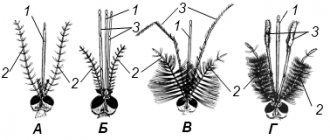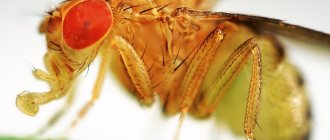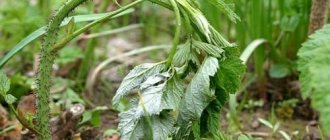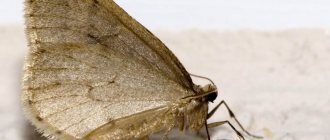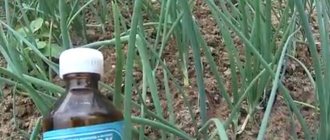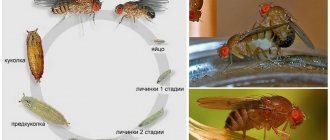What kind of pest is this
The Swedish fly is a member of the family of cereal flies Chloropidae (order Diptera) . It was first described in Sweden by the first taxonomist Carl Linnaeus (1756). About 30 species of this insect are now known.
What does it look like
The adult has an elongated body measuring 1.5-2.5 mm and black in color . The female's abdomen is thicker and ends with a narrow ovipositor. The scutellum is rounded, the dorsum is slightly convex and smooth.
The wings are small transparent with a metallic sheen. On the head there is a small proboscis and black antennae.
Why is it dangerous for winter wheat?
The Swedish fly causes the main damage to winter wheat in the fall . Emerging at the end of September, the females lay eggs in the leaf axils of young shoots during the period when the second leaf emerges. Then egg laying stops and usually stops after 50% of the third leaf has reached.
The hatched voracious larvae, which are twice the size of an adult, penetrate the shoots at the base of the stem. There they eat upward, reaching the ear bud, and eat it and the milk grains.
If the Swedish fly larvae damage the main stem, the crop dies , which is why the yield percentage is significantly reduced - by 50%.
Reference! Swedish fly larvae damage about 20 species of cultivated and 46 species of wild cereals.
Reproduction and life cycle
Pests reproduce so quickly that in one season they manage to produce up to 5 generations of individuals if the weather is favorable. The female carefully chooses a suitable place. First, it checks all the stems, stroking them with its antennae, and then lays eggs in cereal plants that have reached a certain stage of the growing season. The size of the eggs is 0.7-0.8 mm.
The larvae develop within the egg for approximately eight days , then emerge in search of food. With the help of special salivary glands that secrete a specific enzyme for the breakdown of plant tissue, the rudiments of future wheat grains are absorbed.
In nature, the life cycle of larvae is about a month with sufficient nutrition, in laboratory conditions - up to 40 days. They can survive without food for a maximum of seven days.
The insect spends the winter hibernating as a pupa in the stubble of perennial cereals and on the seedlings of winter crops. Activates with the arrival of spring at temperatures above +12°C.
It can be useful:
Wheat pests and diseases, photos and descriptions
Why is wheat smut dangerous and how to deal with it?
spring fly
Distributed everywhere in Ukraine. Damages winter and spring wheat, barley, and other grains. Insect 4-5 mm long. The body is black, velvety, only the pronotum and abdomen have a grayish coating. The wings are dark, with black-brown veins. Legs are black. Eggs up to 1.2 mm, white, somewhat curved. Larva up to 8 mm, white or yellow. Puparium – 5 mm, ovoid, brownish-brown.
It overwinters in the puparia stage in the soil at a depth of up to 3 cm. Flight begins in mid-April - early May. The established crops are colonized by the pest in the seedling phase. The fly lays eggs in the vagina of the leaf. After 2-8 days, the larvae hatch, they penetrate the stem and make passages in it. Damage caused by an angry fly is similar to damage caused by a Swedish fly; When feeding, adult fly fly larvae destroy more of the stem and tillering node and cause complete death of plants. Pupates in the soil, near the base of the plant damaged by it. Some of the puparia overwinter, and from some, at the end of August, second-generation flies fly out and lay eggs on winter crops. Damage to winter crops is the same as to winter crops.
Reasons for appearance
The main reason for its widespread appearance is the ability to adapt to different climates . There are other factors that contribute to the spread of the population on winter wheat:
- Long warm autumn . The period of pest activity increases (at a temperature of +10°C, the insect already goes into hibernation).
- Aridity . Dry weather promotes active growth and development of larvae.
- Nutritional conditions for the growth of winter crops. The more food that enters the plant, the stronger it is, and the stages of development occur much faster. Consequently, the Swedish fly’s period of eating the plant is reduced, since it causes damage at a certain phase of the crop’s growing season.
- Favorable temperature for the period of larval growth (above +10 °C).
- The ability of an insect to migrate over long distances.
Symptoms of the lesion
First of all, the larvae influence the development of the stem . The central leaf withers and turns yellow, sometimes it is completely absent: it either falls off or does not come out of the leaf sinus. External signs of damage caused by the Swedish fly appear approximately two weeks after the larvae settle.
The plant tries to direct forces to the damaged areas, so the color of the leaves becomes intense green and the stems thicken. Using this feature, specialists accurately determine the presence of the Swedish fly in wheat fields.
Maliciousness
The greatest danger to cereals is the larvae of the Swedish fly, which eats away the cone of the cereal and all adjacent tissues, which leads to the death of the central leaves and, accordingly, to a slowdown in growth or death of the entire plant.
Damaged specimens are distinguished by dark greenery and thickening of the stem - the trunk thus tries to compensate for the affected internal tissues. Productivity decreases, as the larvae gnaw out milk grains, preventing them from ripening.
The total amount of losses consists of many factors:
- aridity;
- plant nutrition conditions (the better they feed, the higher the likelihood of survival);
- delayed tillering (plants with several lateral stems will easily tolerate infection);
- air temperature (at minus 10, flies stop laying eggs and hibernate);
- choice by a fly to lay eggs on lateral or central stems.
Fighting methods
The damage caused by insects can be significantly reduced with the correct choice of means of combating it.
Agrotechnical
The most effective ways:
- Maintaining crop rotation . The best predecessors: legumes (clover, alfalfa, peas, soybeans, vetch-oat mixture), corn, annual grasses except sorghum and Sudan grass. It is not advisable to sow wheat on one plot for more than two years.
- Selection of stable seed material with strong fiber that protects the ear from damage by larvae.
- Sowing late varieties (for example, Mirostan, Chaus, Krasnodol) at the optimal time so that winter crops begin to rise with the onset of frosts, when flies hibernate.
- Increasing the grain sowing rate, so that out of the number of sprouted ears, most of them survive and the harvest remains at the same level.
- Deep plowing of the soil.
- Application of nitrogen fertilizers to fields with winter crops to increase plant viability.
Chemical
During the egg-laying and mass summer periods, chemical treatment of wheat is carried out . Using aviation, winter crops are pollinated when their development is in the first leaf phase. In many areas, 12% hexachlorane dust is widely used.
The population of harmful insects is reduced when plants are sprayed with organochlorine and organophosphorus agents. Insecticidal preparations are also used, for example, “Cruiser” and “Celest Top”.
Attention! The death of the fly after treatment reaches 93%, the yield increases by 20% or more.
Preventive measures
To obtain a high yield, preventive measures are necessary:
- Timely peeling of stubble to destroy the pest and its larvae.
- Sowing with high-grade calibrated seeds. They produce friendly and strong shoots, and these are more resistant to the attacks of the Swedish fly.
- Treating grains before sowing into the soil. The drugs “Gaucho” and “Cruiser” are used.
- crops with grain crops after legumes or row crops.
Diet of Swedish flies
Adults feed on the nectar of rapeseed, buckwheat, lupine, anise and other wild plants. The Swedish fly has an excellent sense of smell, so it is not at all difficult for it to find a flowering field. In addition, Swedish flies love to feast on molasses. And they eat tiny aphids as protein food.
Thanks to its good sense of smell, the Swedish fly finds a field with flowering cereals and feeds there.
Other pests of winter wheat in seeds, plantings and warehouses
The number of cereal pests is very large. Let's talk about those causing the greatest harm.
bug turtle
The insect prefers to feed mainly on wheat, damaging crops of both winter and spring crops . Externally it looks like a tiny turtle. The development cycle of the bug is directly related to the growing season of cereals, so throughout the entire summer period the turtle leads an active lifestyle, causing significant damage both in the fields and in storage facilities.
bug turtle
Trips
Wheat thrips damages winter and spring wheat , as well as some cereal perennial grasses. Both adults and larvae are harmful. The insect feeds on fresh juice from the spike scales or from a young succulent leaf, as a result of which the cereal stops growing.
The grains in the ear receive severe damage - they become chipped and defective, which affects the overall quality of the seed. Externally, thrips is a small black-brown fly with poorly developed wings and a size of 1.3-1.5 mm.
Wheat thrips
Ground beetle
The bread ground beetle causes the greatest damage to winter wheat . The larvae of this pest begin their activity during the period of rising and beginning of tillering of seedlings. They eat leaves and young stems, turning wheat bushes into soaked fiber. Adult beetles infect the ears. They gnaw the scales of the ear, the rudiments of the grains, and gnaw out the ripening grains.
The insect size is 12-17 mm, color is pitch black with a bronze tint . The head is large, the antennae are short, the elytra are convex with deep punctate grooves.
Ground beetle
Weevil
The beetle's mouthparts are an elongated proboscis . With its help, the insect destroys the dense skin of grain or cereal. The weevil is considered one of the main and most dangerous pests of grain crops - wheat, barley, buckwheat, corn, as well as pasta; it destroys stocks both in the kitchen and in huge grain storage facilities.
The insect has an elongated body measuring about 4 mm, dark brown, almost black in color . If it has wings, it is not adapted for flight, but it moves long distances on ships and trains carrying industrial batches of grain.
Weevil
How to deal with wheat pests
Measures to combat the listed pests and preventive procedures are carried out approximately the same and include:
- Agrotechnical measures : stubble peeling and deep fall plowing, compliance with crop rotation and sowing dates, growing resistant varieties.
- Chemical : spraying grain with approved types of insecticides, for example, “Karate”, “Arrivo”, “Fastak”, “Aktelik”.
- Preventative : before storing in storage, treat grain with agents based on carbendazim, mancozeb, triticonazole. And also maximum drying of the product, thorough cleaning of the room, disinfection of the storage, for example, with formaldehyde vapor (after this, the storage is kept hermetically sealed for 2-3 days, then thoroughly ventilated).




